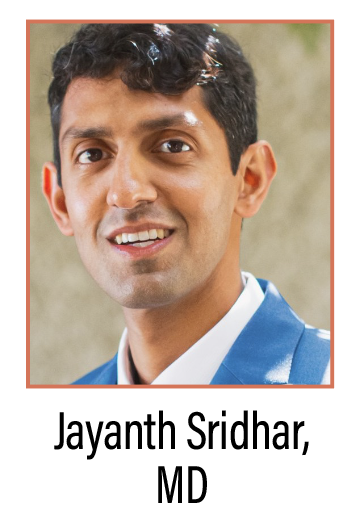 |
|
Bio Dr. Sridhar serves as Retina Specialist Magazine’s Social Media Ambassador. He’s an associate professor of clinical ophthalmology at Bascom Palmer Eye Institute, Miami. DISCLOSURE: Dr. Sridhar is a consultant to Alcon, DORC, Genentech/Roche and Regeneron Pharmaceuticals. |
I was sitting on my couch watching the 2024 NBA Slam Dunk Contest while texting with my basketball-enthusiastic friends when Jaylen Brown of the Boston Celtics brought a fan from the audience to sit in a chair so he could jump over him while dunking. The graphic provided by Turner Sports identified this fan as “Kai Cenat.” One of my friends (and fellow retinal surgeon) immediately group texted, “I must be finally too old because I have no idea who Kai Cenat is.” A quick Google search revealed that he is an “online streamer and YouTuber,” otherwise known as an influencer.
The Rise of Influencing
The term “influencer” predates the rise of social media. It refers to a person or entity whose behavior or statements trickle down to influence the behavior of followers. Celebrities such as Coco Chanel and Michael Jordan were influencing our spending habits decades before the first social media applications were released. The first online influencers were bloggers, but digital influencing skyrocketed with the release of Instagram in 2010. A picture is worth a thousand words and, as it turns out, billions of dollars. By 2013, Instagram included paid ads, and influencers could directly share products they’ve enjoyed and get paid for it.
Though influencing isn’t new, what has changed with social media is the democratization of becoming an influencer. Anyone with a working smartphone and an idea can now collect a base of followers with interesting posts, pictures, livestreams and/or TikTok videos. Similarly, social media has leveled the playing field for medical influencers. The medical influencers of yesteryear were a small group of key opinion leaders who were at the top universities and/or medical practices, had access to the most clinical and research knowledge, and would speak at congresses and smaller regional meetings to educate the physician public. For retina, the intravitreal injection boom heralded a prodigious generation of influencers who were looked to for guidance on which drug to use, how to decide treatment initiation and cessation, and how to interpret clinical trial results in the context of real-world practice. Drug companies paid, and continue to pay, KOLs (me included) to deliver branded drug and disease-state lectures. Interests are aligned: greater adoption of newer medication may result in superior patient outcomes and supports the pharmaceutical industry’s financial motivations.
Influencing the Retina Space
Democratization via social media exists in the retina space for budding influencers. Exciting surgical videos, podcast discussions of the literature, commentary on international meeting highlights, and reposting of results of peer-reviewed publications are just a few of the ways any retinal specialist can build a following. With followers comes influence, and with influence comes both responsibilities to be ethical and, whether they are fair or not, perceptions of clinical and academic competence. For a retinal specialist hoping to become a KOL, social media is now the most easily accessible route, as it doesn’t rely on connections via mentors, institutional affiliations, or perceived pedigree based on training background.
For social media, influencing has been predicted to merge with AI, corporate interests and international politics into a murky and potentially dark field of computer-generated influencing, where bots may produce images and content of purported human beings who accumulate followers. Hopefully, we’re able to stave off this dangerous tech from infiltrating the medical consciousness, as prescribing patterns should be kept sacrosanct. For now, enjoy those LinkedIn, Instagram and TikTok retina images and videos. Just remember to take it all with a grain of salt until we devise better ways to validate and cross-check digitally distributed content. RS



